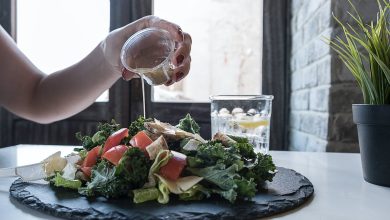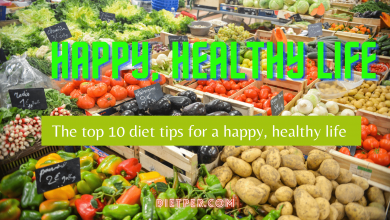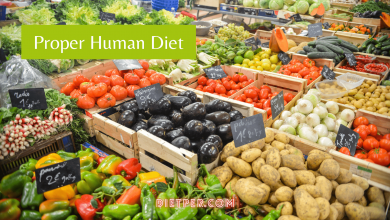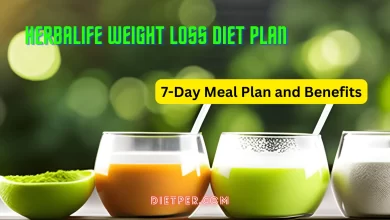7-Day Meal Plan for Pancreatitis: Soothe Inflammation & Improve Digestion
Pancreatitis-Friendly Diet: 7-Day Meal Plan for Optimal Health
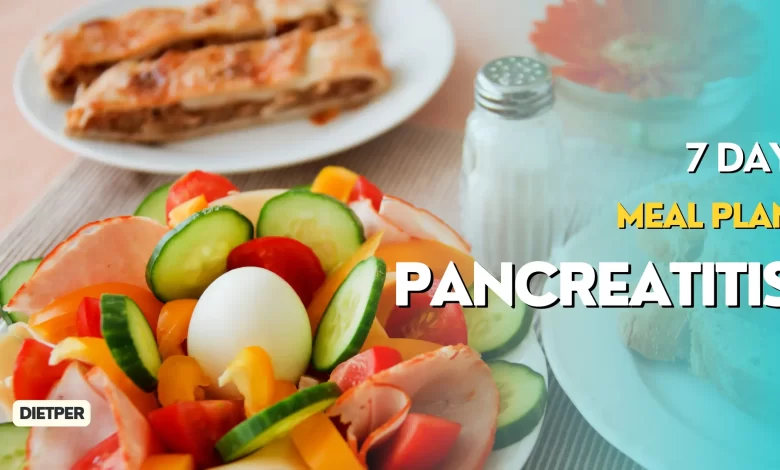
7-day meal plan for pancreatitis :- Pancreatitis is a condition that causes inflammation of the pancreas, leading to pain, discomfort, and digestive issues. Diet plays a crucial role in managing pancreatitis, and a well-planned meal plan can help reduce inflammation, improve digestion, and promote overall health. This article presents a 7-day meal plan for pancreatitis, providing detailed information on what to eat and what to avoid.
7-Day Meal Plan for Pancreatitis
Day 1
- Breakfast: Steel-cut oats cooked with non-fat milk, mixed fresh berries, and one teaspoon of ground flax seed.
- Lunch: Mediterranean-style tuna (canned in water) mixed with black olives, sundried tomato, fresh basil, and low-fat feta. Served with whole grain crackers.
- Dinner: Baked sheet pan dinner with chicken thighs, carrots, broccoli, onions, garlic, and sweet potato.
- Snacks: Unsalted pretzels with hummus.
Day 2
- Breakfast: Spinach smoothie with non-fat Greek yogurt, banana, and a tablespoon of cocoa powder.
- Lunch: Shredded salad with brussels sprouts, kale, carrots, raisins, and a grilled chicken. Conservatively dress your salad with a simple balsamic and olive oil dressing.
- Dinner: Grilled salmon with brown rice, asparagus, and bell peppers. Garnish your fish with homemade pineapple salsa and fresh herbs.
- Snacks: 1 cup of green tea.
Day 3
- Breakfast: Scrambled tofu served on whole grain toast, with low-fat cheddar cheese and a spoonful of tomato salsa.
- Lunch: Rice bowl with cooked salmon, broccoli, and red cabbage. Dress with a small amount of sesame oil, sesame seeds, and a splash of rice wine vinegar.
- Dinner: Lentil-turkey meatballs served with spaghetti and red sauce. Add peppers and onions to your sauce to increase the vegetables, or add a side salad.
- Snacks: Whole grain crackers and hummus, top with sliced cucumber.
Day 4
- Breakfast: Oatmeal with non-fat milk, sliced banana, and a sprinkle of cinnamon.
- Lunch: Grilled chicken breast with quinoa, steamed vegetables, and a lemon-tahini dressing.
- Dinner: Baked cod with a side of roasted sweet potatoes and green beans.
- Snacks: Fresh fruit and a handful of nuts.
Day 5
- Breakfast: Smoothie with non-fat Greek yogurt, mixed berries, and a tablespoon of chia seeds.
- Lunch: Grilled chicken salad with mixed greens, cherry tomatoes, cucumber, and a light vinaigrette.
- Dinner: Baked chicken thighs with a side of steamed vegetables and brown rice.
- Snacks: Rice cakes with avocado spread and cherry tomatoes.
Day 6
- Breakfast: Whole grain toast with avocado and a sprinkle of salt and pepper.
- Lunch: Grilled shrimp with a side of quinoa and steamed vegetables.
- Dinner: Baked turkey breast with a side of roasted vegetables and sweet potato.
- Snacks: Fresh fruit and a handful of almonds.
Day 7
- Breakfast: Scrambled eggs with spinach and a side of whole grain toast.
- Lunch: Grilled tofu with a side of quinoa and steamed vegetables.
- Dinner: Baked salmon with a side of roasted vegetables and brown rice.
- Snacks: Fresh fruit and a handful of walnuts.
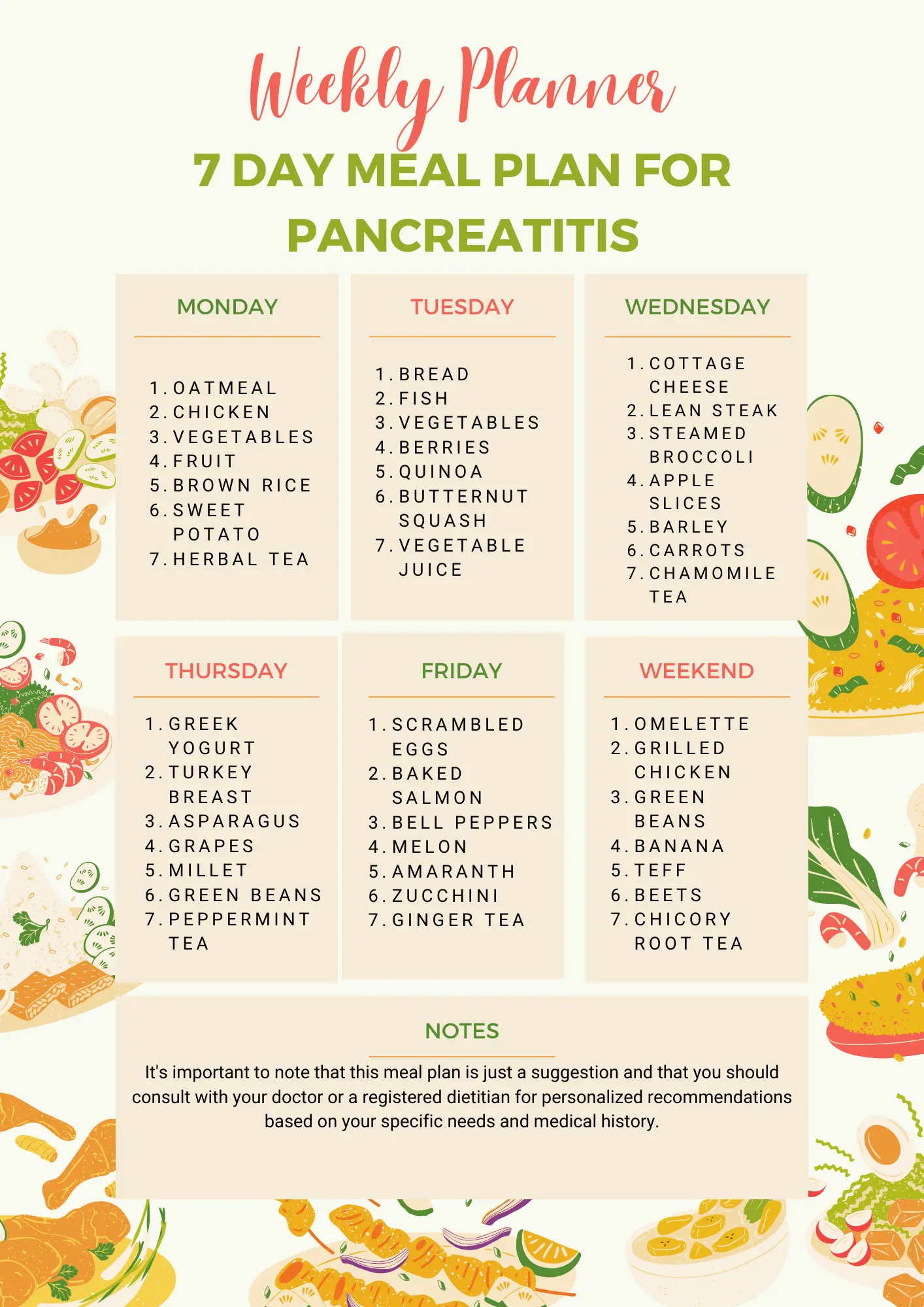
Foods To Avoid
To help your pancreas stay healthy and feel better if you have pancreatitis, it’s best to avoid certain foods:
- Alcohol: Drinking alcohol can make pancreatitis worse and cause more problems. It’s better to not drink at all or have only a little now and then.
- Fatty foods: Foods with a lot of fat can make your pancreas work too hard. Stay away from things like fried foods, butter, full-fat dairy, and mayo.
- Processed foods: These often have too much fat, so it’s best to avoid them.
- Red meat and organ meat: These are also high in fat and can be tough for your pancreas to handle. Choose lean proteins like chicken, fish, tofu, and beans instead.
- Fried and highly processed foods: They’re tough to digest and can make pancreatitis symptoms worse.
- Caffeine: Caffeine can bother your pancreas, so try not to have too much coffee, tea, or other drinks with caffeine.
- Whole grains, nuts, and raw fruits and veggies: These can be hard to digest because of the fiber they have. Stick to foods that are easier on your pancreas.
- Sugary foods: Too much sugar can make you gain weight and increase your chances of getting pancreatitis again. Try to limit how much sugary stuff you eat.
Food To Eat
When planning your meals for pancreatitis, it’s crucial to pick foods that are gentle on your pancreas while still providing essential nutrients. Here’s what you should include:
- Lean proteins: Choose chicken, fish, tofu, and beans to get your protein without overworking your pancreas.
- Fruits and vegetables: Make sure to include a variety for vitamins and minerals.
- Whole grains: Opt for quinoa, oats, and whole grain crackers for energy and fiber.
- Low-fat dairy: Use skim milk, low-fat yogurt, and reduced-fat cheeses for calcium and protein.
- Beans and legumes: They’re excellent sources of plant-based protein and fiber.
- Nuts and seeds: Add almonds, chia seeds, and flax seeds for healthy fats and nutrients.
- High-fiber foods: Regularly include fruits, veggies, whole grains, beans, and nuts to keep your digestion on track.
- Healthy fats: Use olive oil, avocado, and nuts in moderation for good fats.
- Stay hydrated: Drink plenty of water to help with digestion.
- Consider supplements: Talk to your doctor about using digestive enzymes and probiotics to aid digestion and reduce inflammation.
By including these foods in your meals throughout the week, you can ensure your pancreatitis diet is packed with essential nutrition.
- The Ultimate Miracle Weight Loss Drink Recipe for 2024
- The TLC Diet: Lowering Cholesterol for a Healthier Heart
- Clean Bulking Diet Plan: The Ultimate Guide to Lean Muscle Gain
Recommended daily intake of dietary fat for people with pancreatitis
For folks with pancreatitis, it’s generally advised to keep their daily fat intake under 50 grams, as suggested by the National Pancreas Foundation. This helps lighten the load on the pancreas and reduces any digestive discomfort. But it’s worth noting that everyone’s needs are different, so some might need even less or a bit more fat depending on how they respond to dietary changes.
A low-fat diet doesn’t necessarily mean skimping on calories. It’s crucial to still get enough protein, vitamins, and minerals to support healing and overall health. That’s why teaming up with a healthcare pro or a dietitian is key to creating a personalized diet plan that works for you.
Apart from watching fat intake, other tips for managing pancreatitis include steering clear of alcohol, cutting back on caffeine, picking lean protein sources, going for low-fiber foods, and staying hydrated. And sometimes, supplements like digestive enzymes and probiotics can be helpful for digestion and reducing inflammation.
The effect of dietary fat content on the recurrence of pancreatitis
Researchers are investigating how dietary fat might affect the recurrence of pancreatitis in a study called the EFFort of dietary fat content on the recurrence of pancreatitis (EFFORT). This study is looking at how changing the amount of fat in the diet might impact the chances of pancreatitis coming back, as well as other factors like mortality, blood lipids, and weight loss in cases of pancreatitis with no clear cause.
This study is important because it could give us valuable information about how dietary fat plays a role in managing and preventing pancreatitis from coming back. The results could help doctors make better recommendations about what to eat for people with pancreatitis.
However, the study is still ongoing, so we don’t have the results yet. Once the study is finished and the results are published, we’ll have a better idea of how dietary fat affects pancreatitis recurrence.
can i eat dairy products in a pancreatitis diet ?
In a pancreatitis diet, dairy products like milk can be okay to have, but it’s important to be careful and not overdo it. Choosing low-fat or fat-free options is best.
One study didn’t find a big link between eating dairy and getting pancreatic cancer.
Doctors from Vinmec suggest sticking to low-fat or fat-free milk, yogurt, or milk alternatives if you have acute pancreatitis. They say it’s better to skip high-fat dairy like cheese and milkshakes.
Columbia Surgery talks about having a diet with a moderate amount of fat, about 25% of your calories. They recommend fruits, veggies, whole grains, beans, and low-fat or fat-free dairy, along with lean meat.
Healthline says after a bout of acute pancreatitis, go for low-fat dairy and lean proteins. Avoid high-fat foods and drinks.
There’s a case where someone got pancreatitis from drinking too much milk. So, while dairy in moderation can be okay, it’s important not to go overboard, especially with high-fat dairy. Getting personalized advice from a doctor or dietitian is smart.
Frequently Asked Questions FAQs
What are the best foods for pancreatitis recovery?
The best foods for pancreatitis recovery include lean proteins such as chicken, fish, tofu, or legumes; low-fat dairy products; whole grains; fruits and vegetables; and healthy fats such as avocados, nuts, and olive oil in moderation.
How can I create a 7-day meal plan for pancreatitis?
To create a 7-day meal plan for pancreatitis, choose low-fat, low-fiber, and easily digestible foods. Include lean proteins, low-fat dairy products, whole grains, fruits and vegetables, and healthy fats in your meal plan.
What foods should I avoid in a pancreatitis diet?
Foods to avoid in a pancreatitis diet include fried and fatty foods, high-sugar foods, alcohol, and spicy foods.
How does dietary fat content affect pancreatitis recurrence?
Dietary fat content can affect pancreatitis recurrence by increasing the workload of the pancreas and potentially leading to inflammation.
What is the recommended daily intake of dietary fat for people with pancreatitis?
The recommended daily intake of dietary fat for people with pancreatitis is generally limited to 50 grams per day.
Can I eat dairy products in a pancreatitis diet?
Dairy products can be eaten in a pancreatitis diet, but it is recommended to choose low-fat or non-fat dairy products like skim milk, low-fat yogurt, and cottage cheese.
What are the benefits of a low-fat diet for pancreatitis?
The benefits of a low-fat diet for pancreatitis include reducing the workload of the pancreas, preventing digestive discomfort, and promoting overall health.
How can I manage pancreatitis symptoms with diet?
Pancreatitis symptoms can be managed with diet by choosing low-fat, low-fiber, and easily digestible foods, staying hydrated, and avoiding alcohol and caffeine.
What are the key components of a pancreatitis-friendly meal plan?
The key components of a pancreatitis-friendly meal plan include lean proteins, low-fat dairy products, whole grains, fruits and vegetables, and healthy fats in moderation.
How can I ensure I’m getting enough nutrients while on a pancreatitis diet?
To ensure you’re getting enough nutrients while on a pancreatitis diet, choose a variety of foods, stay hydrated, and consider taking supplements such as digestive enzymes and probiotics under the guidance of a healthcare professional.
Final Words
By following the 7-day meal plan for pancreatitis, individuals with the condition can make informed dietary choices that support their health and well-being. The meal plan emphasizes lean protein sources, low-fat foods, easily digestible grains, and nutrient-rich whole foods, while avoiding high-fat, processed, and difficult-to-digest foods. By incorporating these dietary recommendations, individuals with pancreatitis can manage their symptoms and promote overall health.
